7 Proven Strategies for Effective Business Networking in Asia
BUSINESS TIPS
Alan Wong
8/12/202412 min read


In today's fast-paced Asian business environment, networking is more crucial than ever.
But how do you stand out in a sea of professionals all vying for attention?
As a seasoned Asia business consultant with over 20 years of experience, I've distilled my knowledge into seven proven strategies that will revolutionize your approach to business networking.
Conclusion: The Success of Business Networking
By implementing these strategies, you'll transform your networking approach from a numbers game to a powerful tool for building lasting, mutually beneficial relationships in Asia's business landscape.
Effective networking is an ongoing process.
It's not just about what you can gain, but also what you can contribute to your professional community.
Applying these techniques will make you a sought-after connection, opening doors to new opportunities and partnerships across Asia.
At ToAsia.biz, we're passionate about helping businesses navigate the complex and exciting world of Asian markets.
Our team of experts provides invaluable insights, connections, and strategies to help you succeed in this dynamic region.
Speaking of networking opportunities, we're thrilled to announce our partnership with SXSW Sydney!
This groundbreaking event brings the innovation and creativity of South by Southwest to the Asia-Pacific region for the first time.
SXSW Sydney offers unparalleled networking opportunities with technology, innovation, and creative industry leaders from across Asia and beyond.
It's the perfect place to put your new networking skills into practice!
As a special offer to our readers, we're providing an exclusive discount code for SXSW Sydney tickets:
Discount Code:
Use this code ( S10OFF5 ) during registration to receive 10% off your Badge through our SXSW Sydney exclusive purchasing link.
Don't miss this chance to be part of one of the most exciting networking events in the Asia-Pacific region!
Remember, successful networking in Asia is about building genuine relationships, providing value, and staying connected.
Whether you're at SXSW Sydney or in a local business meeting, these principles will serve you well.
We look forward to seeing you at SXSW Sydney and hearing about your networking successes across Asia!

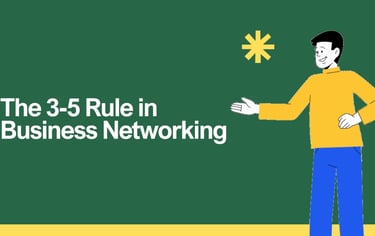
The 3-5 Rule in Business Networking
In my early days of networking across Asia's bustling business hubs, I made the common mistake of trying to collect as many business cards as possible.
I'd return from events with stacks of cards, feeling accomplished. But here's the harsh truth: most of those connections led nowhere.
Enter the 3-5 Rule, a game-changer in my networking approach.
Focus on making 3-5 meaningful connections at events
Set a realistic goal for each event: connect deeply with 3-5 people
Quality trumps quantity every time in Asian business circles
These focused interactions lead to more valuable, long-term relationships
Engage in deep conversations, sharing stories and experiences
Move beyond surface-level small talk
Share your entrepreneurial journey, including the challenges faced
Ask thoughtful questions about their business experiences in Asia
Example: "What's been your biggest challenge in adapting to the business culture in India?"
Build lasting relationships instead of collecting business cards
Aim for connections that extend beyond the event
Discuss potential collaboration opportunities or knowledge exchange
Make concrete plans for follow-up, such as a coffee meeting or video call
Real-world application
At a recent tech conference in Hong Kong, I applied the 3-5 Rule.
Instead of flitting from person to person, I engaged in lengthy conversations with some startup founders.
Each conversation lasted 20-30 minutes, allowing for genuine connection and understanding.
I exchanged stories about my experiences in different Asian markets, discussed challenges unique to the region, and found unexpected areas of potential collaboration.
After the event, I had follow-up meetings with these connections.
One of the startup founders and I are now exploring a potential partnership.
Pro Tip
Use the "two-ear, one-mouth" rule during these conversations.
Listen twice as much as you speak.
This approach is particularly effective in many Asian cultures where listening and showing respect are highly valued.
By focusing on quality over quantity, you'll build a network of genuine relationships that can propel your business forward in Asia's diverse and dynamic markets.
Remember, in the interconnected business world of Asia, having a few strong, trusting relationships can open more doors than a hundred superficial connections.
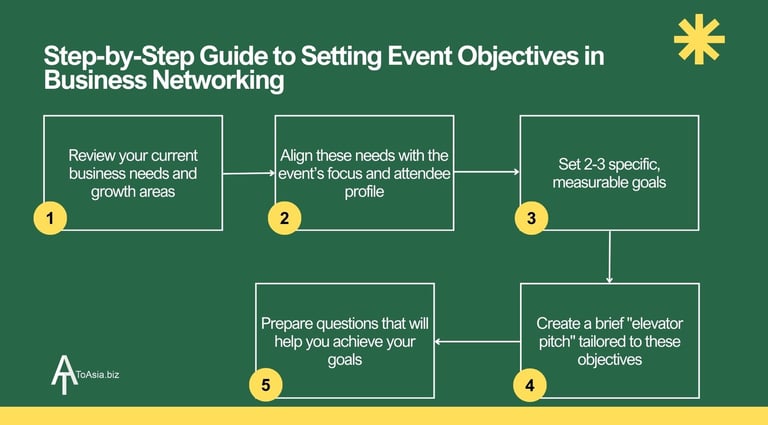

Step-by-Step Guide to Setting Event Objectives in Business Networking
Review your current business needs and growth areas
Align these needs with the event's focus and attendee profile
Set 2-3 specific, measurable goals
Create a brief "elevator pitch" tailored to these objectives
Prepare questions that will help you achieve your goals

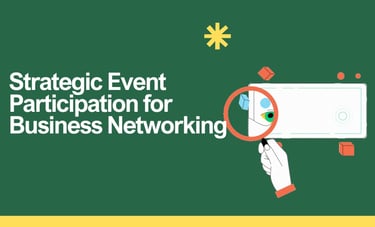
Strategic Event Participation for Business Networking
Let's face it: not all networking events are created equal, especially in Asia's diverse business landscape.
I learned this the hard way after wasting countless hours at ill-fitted events early in my career.
Strategic event participation is about maximizing your time and opportunities.
Here's how to do it right:
Choose events aligned with your industry and goals
Identify your networking objectives
Are you looking for potential clients?
Seeking investors?
Exploring partnerships?
Research events that cater to your specific industry or niche
Look for events that attract decision-makers in your target market
Early in my consulting career, I attended a general business mixer in Hong Kong.
I realized I was the only tech consultant in a room full of real estate agents.
Remember to always verify the attendee profile before committing.
Research attendees and speakers beforehand
Some events publish attendee lists or at least highlight key participants
Use LinkedIn to research the backgrounds of interesting attendees or speakers
Prepare talking points or questions based on their expertise or recent achievements
In Asia like South Korea, hierarchy and titles often matter.
Taking your time to understand the Korean business culture is crucial.
Knowing someone's position can help you tailor your approach and show respect, which is crucial in many Asian business cultures.
Set specific networking objectives for each event
Define clear, achievable goals for each event you attend.
For example:
I want to connect with three potential clients in the healthcare tech sector at SXSW Sydney 2024.
I want to identify two possible mentors in the e-commerce space.
I want to learn about at least one new market trend from industry leaders.
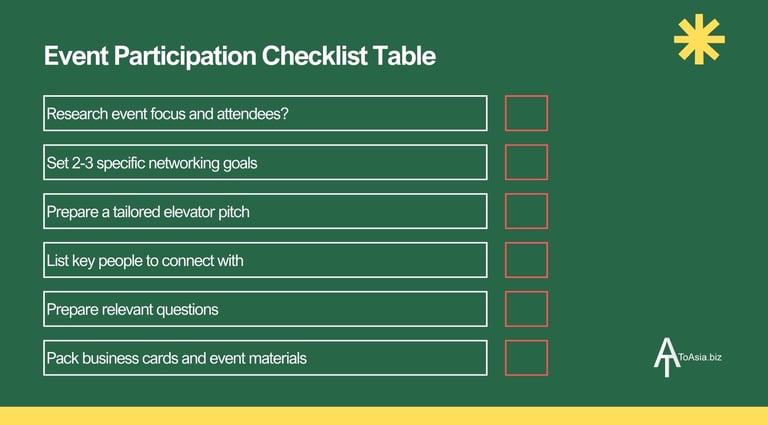

Event Participation Checklist Table
Research event focus and attendees
Set 2-3 specific networking goals
Prepare a tailored elevator pitch
List key people to connect with
Prepare relevant questions
Pack business cards and event materials
Remember, strategic event participation is about quality, not quantity.
It's better to attend fewer events but make a bigger impact at each one.
By choosing the right events, preparing thoroughly, and setting clear objectives, you'll transform your networking efforts from hit-or-miss to consistently productive.
Next time you're considering an event, ask yourself:
"Does this align with my business goals in the Asian market?"
If the answer isn't a resounding "yes,"
it might be better to sit this one out and wait for a more targeted opportunity.
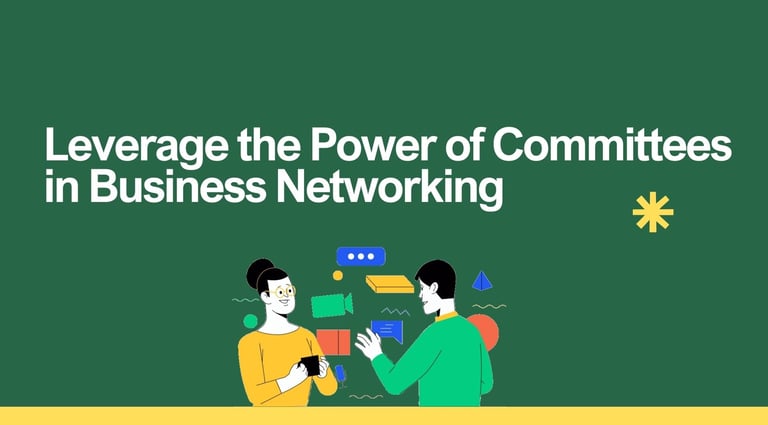

Leverage the Power of Committees in Business Networking
Ever feel like you're always on the outside looking in at networking events?
I've been there, and I've discovered a powerful secret: committee membership.
This strategy transformed my networking game in Asia's competitive business landscape.
Let's dive into how you can leverage committees to supercharge your networking efforts.
Join organizing committees or volunteer for industry associations
Identify key industry associations in your field
Look for opportunities to join event-organizing committees
Volunteer for roles that match your skills and interests
Personal Anecdote:
Many years ago, I joined the organizing committee for a major tech expo in Hong Kong.
At first, I was just handling small tasks like coordinating speakers.
But this foot in the door led to incredible networking opportunities I never would have had otherwise.
Gain visibility and credibility within your professional community
Contribute ideas and work actively in your committee role
Showcase your expertise by organizing relevant sessions or panels
Build a reputation as a reliable and knowledgeable industry member
In many Asian business cultures, being part of a respected committee can significantly boost your professional standing.
It's seen as a mark of trust and expertise.
Access exclusive networking opportunities as an insider
Attend VIP events and closed-door meetings
Get introduced to high-profile industry figures
Be part of decision-making processes that shape your industry
Committee membership is not just about attending meetings.
It's about actively contributing and leveraging your position to create value for yourself and others.
When you give your time and expertise, you'll find that networking opportunities naturally flow your way.
Don't spread yourself too thin.
Choose one or two committees where you can truly make an impact, rather than joining every group available.
Quality of involvement trumps quantity every time.
Next time you're at an industry event in Asia, don't just think about how you can network as an attendee.
Ask yourself: "How can I get involved in making events like this happen?"
That's where the real networking magic begins.
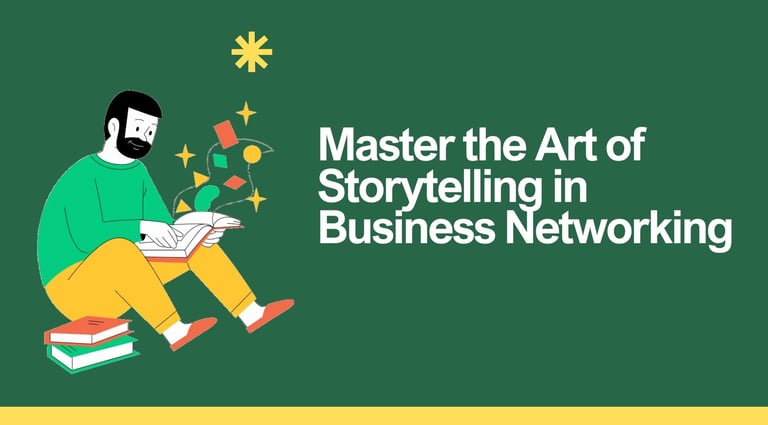

Master the Art of Storytelling in Business Networking
In the bustling business hubs of Asia, from Tokyo to Singapore, everyone's vying for attention.
How do you stand out?
The answer lies in the age-old art of storytelling.
I've learned that a well-crafted story can open doors faster than any business card ever could.
Craft a compelling personal brand narrative
Identify your unique value proposition
Develop a clear, concise "elevator pitch"
Tailor your story to resonate with Asian business values
My Experience:
When I first started networking in China, I struggled to connect.
My pitch was all facts and figures.
Then, I started sharing the story of how I navigated cultural misunderstandings in my first Asian venture.
Suddenly, people were engaged, asking questions, and remembering me long after events.
Share authentic experiences, including failures and lessons learned
Be vulnerable – it makes you relatable
Highlight how you overcame challenges
Connect your experiences to broader business principles
In many Asian cultures, humility is highly valued.
Sharing failures can enhance your credibility, as long as you focus on the lessons learned and growth achieved.
Elements of a Powerful Business Story Table
Hook: An attention-grabbing opening
Conflict: The challenge faced
Journey: Steps taken to overcome the challenge
Resolution: Outcome and lessons learned
Relevance: How the story relates to the listener
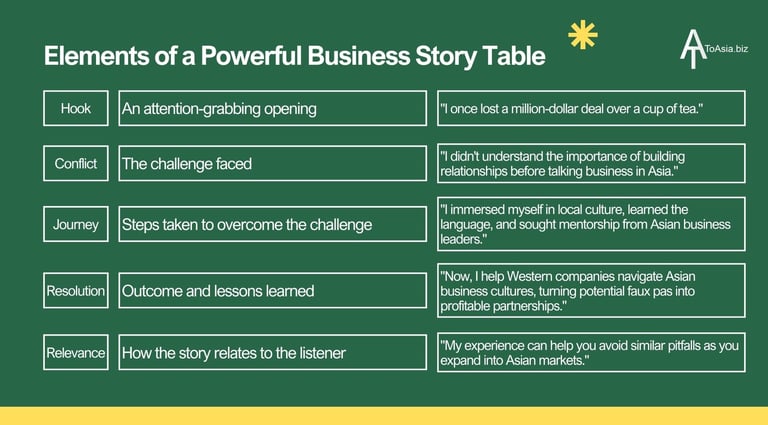

Continuous Value Exchange in Business Networking
Networking isn't a one-time event; it's an ongoing process of give and take.
In my years of navigating the diverse business landscapes of Asia, I've found that the most valuable connections are built on a foundation of mutual benefit.
Regularly share industry insights or helpful resources
Curate and share relevant articles, reports, or news items
Offer your unique perspective on industry trends
Create original content (blog posts, videos, podcasts) to showcase your expertise
Introduce contacts to each other when mutually beneficial
Identify potential synergies between your connections
Always ask permission before making introductions
Provide context on why you think the introduction would be valuable
In many Asian business cultures, being a connector is highly valued.
Thoughtful introductions can significantly enhance your reputation and expand your network.
Types of Valuable Introductions
Mentor-Mentee: Connecting experienced professionals with those seeking guidance
Complementary Skills: Linking professionals with complementary expertise
Geographic Bridge: Introducing contacts across different Asian markets
Investor-Innovator: Connecting investors with promising ventures
Problem-Solver: Linking someone with a challenge to someone with a solution
Offer assistance without expecting immediate returns
Be genuinely helpful without always having an agenda
Share your knowledge and expertise freely
Celebrate others' successes and milestones
In the world of networking, what goes around comes around.
By consistently providing value, you position yourself as a trusted resource and connector.
While being helpful is crucial, be mindful of your own boundaries and resources.
It's okay to politely decline requests that are too time-consuming or outside your area of expertise.
Your network is your net worth.
Nurture it wisely, and watch your opportunities multiply.
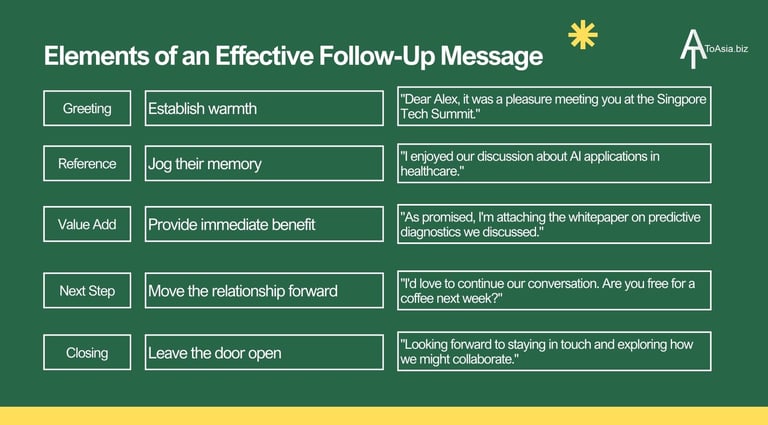

Use storytelling to create memorable connections
Adapt your story to different networking situations
Encourage others to share their stories
Use stories to illustrate your points in conversations
Storytelling isn't about boasting.
It's about sharing experiences that others can learn from or relate to.
A good story makes you memorable and opens the door for deeper connections.
While storytelling is powerful, be mindful of your audience.
In some Asian contexts, especially formal business settings, it may be appropriate to start with a more traditional introduction before easing into storytelling.
Next time you're preparing for a networking event in Asia, ask yourself: "What story can I share that will resonate with this audience?"
Craft your narrative, practice it, and watch as it transforms your networking experience.


Utilize Digital Platforms Effectively for Business Networking
Your online presence is often your first impression. I've learned that mastering digital platforms can exponentially expand your networking reach. From LinkedIn to WeChat, each platform offers unique opportunities to connect and engage.
Maintain an up-to-date LinkedIn profile
Craft a compelling headline that showcases your expertise
Write a summary that tells your professional story
Regularly update your experience and skills
Previously, I underestimated the power of LinkedIn in the Asian market.
My profile was bare-bones and rarely updated.
One day, a potential client mentioned they almost didn't reach out because my profile looked inactive.
That was my wake-up call. After revamping my LinkedIn presence, inbound opportunities increased tenfold within months.
Step-by-Step Guide to Optimizing Your LinkedIn Profile:
Choose a professional, approachable profile photo
Create a headline that goes beyond your job title (e.g., "Bridging Western Innovations with Asian Markets | Tech Consultant")
Write a compelling summary that highlights your unique value proposition
Showcase key projects and achievements in your experience section
Add relevant skills and seek endorsements
Request recommendations from colleagues and clients
Engage with your network by sharing insights and commenting on posts
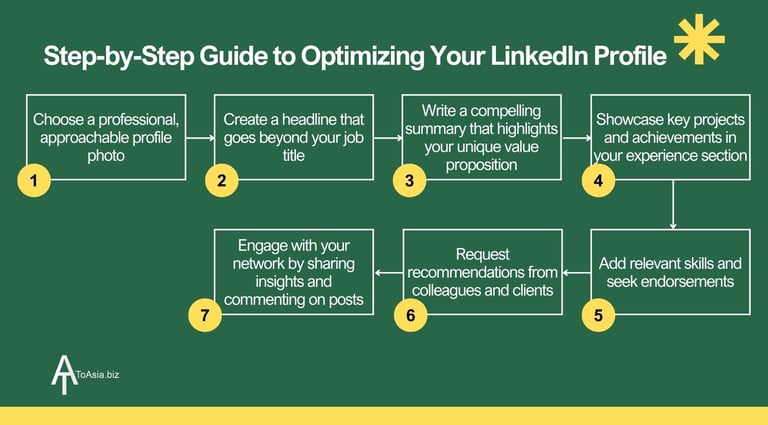

Engage regularly on industry-specific online forums
Identify key forums and discussion groups in your industry
Contribute valuable insights and answer questions
Build your reputation as a knowledgeable industry player
In many Asian business cultures, sharing knowledge is highly valued.
Consistently providing helpful information on forums can significantly boost your credibility and attract potential connections.
Use social media to nurture professional relationships
Share industry insights and thought leadership content
Engage with others' posts through thoughtful comments
Use direct messaging features for one-on-one conversations
Effective digital networking isn't about broadcasting.
It's about engaging in meaningful conversations and providing value to your network.
Be mindful of platform preferences in different Asian countries.
Tailor your digital networking strategy to the platforms most relevant to your target markets.
Set aside 30 minutes each day for digital networking.
Comment on three posts, share one insightful article, and reach out to one new connection.
Consistency is key to building a strong online presence.
With the right approach, every login can be a chance to expand your professional network across Asia.


The 48-Hour Rule for Following Up
In the fast-paced business world of Asia, timing is everything. I've learned that the difference between a fleeting encounter and a valuable connection often comes down to one thing: prompt follow-up. Enter the 48-Hour Rule, a game-changer in my networking playbook.
Connect with new contacts within 48 hours of meeting
Set a reminder immediately after exchanging contact information
Use the platform they prefer (e.g., WeChat in China, LINE in Japan, WhatsApp in Hong Kong)
Strike while the iron is hot – your conversation is still fresh in their mind
Early in my career in Hong Kong, I met a potential client at a conference.
We had a great chat, but I waited a week to follow up.
By then, he had already engaged a competitor.
That missed opportunity taught me the value of prompt action.
Now, I never let 48 hours pass without reaching out to a new contact.
Send personalized follow-up messages referencing your conversation
Mention specific points from your discussion to jog their memory
Express genuine interest in their work or ideas
Provide any information or resources you promised during your chat
In many Asian cultures, relationship-building is crucial before diving into business.
Use your follow-up to further this connection, not just to pitch your services.
Propose concrete next steps or opportunities for collaboration
Suggest a specific date and time for a follow-up call or meeting
Outline potential areas for collaboration based on your initial conversation
Offer to make introductions to relevant contacts in your network
The 48-Hour Rule is not just about speed; it's about making a memorable second impression.
Your prompt, thoughtful follow-up shows professionalism and genuine interest in the relationship.
While prompt follow-up is crucial, be mindful of timing in different Asian cultures.
For example, sending a business message during Chinese New Year might be seen as inappropriate.
Always consider the cultural context in your timing.
Table: Elements of an Effective Follow-Up Message


Alan Wong is founder of ToAsia.biz and a startup mentor with over 20 years of professional experience managing software, Saas and consulting services MNCs.
About Author
Copyright © 2025 ToAsia.biz


We lead your business to Asia
Our Business Growth Experts help SaaS businesses achieve growth in Asia and become profitable FAST.
Send us a message via WhatsApp
